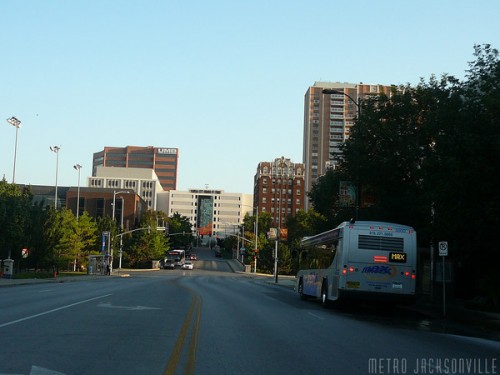
Last night I had the opportunity to finally attend one of the Indyconnect Round 2 meetings. It was a little different from the Round 1 meetings, in that it was more of a community meeting where one could sign up to stand and comment or ask questions. I was near the end of the roughly dozen people who stood up and commented or asked questions. There were many interesting questions, but the overwhelming theme was: “What happened to light rail on Washington Street?” The answer that officials on hand gave was that it was purely a financial decision. The support is obviously there, but the budget cannot support it.
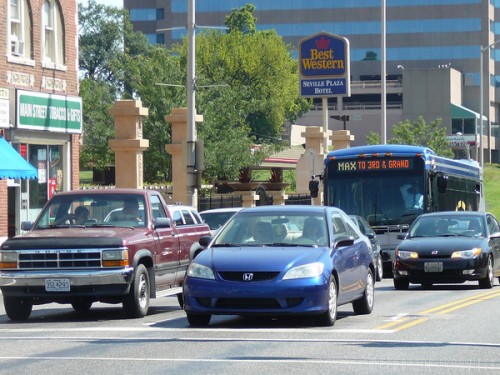
I made a couple of pointed inquiries at the meeting and also this morning, regarding the Washington Street BRT plan. My initial question revolved around how Indianapolis could successfully transition an existing BRT line into a light rail corridor and keep the share of riders that it had built up. Ottawa, Canada is struggling with this issue right now. Years ago they developed a robust BRT system and at this point, it’s downtown sections are so congested with bus traffic, to construct a LRT guideway would literally snuff the existing bus riders. A similar condition could also hamper efforts to convert Washington Street BRT to LRT years in our future given that LRT is planned for an alignment along the median of Washington Street to replace what would have been a perceived transit-way for buses.
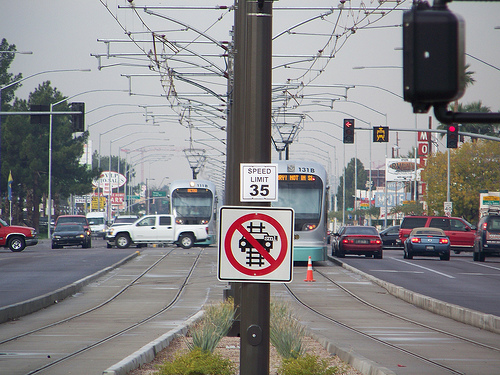
However, when I dug into the matter I discovered details not readily apparent in recent Indyconnect release literature. What planners were tasked with falls significantly short of the general expectation for BRT, something I examined in my post last week . What we can expect out of a Washington Street BRT is similar to Kansas City’s MAX system. I did a little digging and found a nice post from Metro Jacksonville (sort of the Urban Indy of Jacksonville, FL). They did some investigating of the KC MAX line and have a nice report online if you want to read about it.
In case you don’t want to check it out, the overriding opinion is clear: Kansas City’s MAX system is NOT a real BRT system and it’s lack of infrastructure investment has not spurred ANY DEVELOPMENT WHATSOEVER along it’s 6 mile route. Ridership has risen 50% along the route which in itself is commendable, but in terms of attracting economic investment, there has not been anything substantial to speak of.
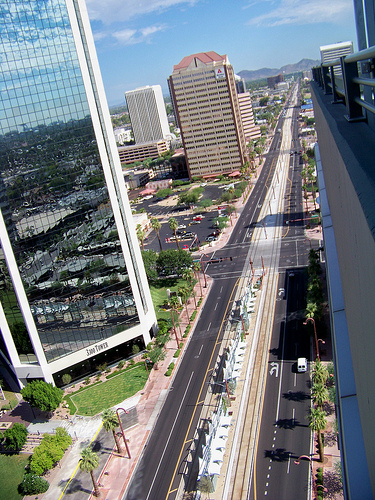
Essentially, what we are getting is a dressed up bus to run within the constraints that exist today. There will be some traffic signal priority given, with fewer stops so that true express bus service is offered. That is commendable and will provide significant mobility to those choosing to ride. However, that word, “choose” is the crux of this article. Will people choose to ride this bus? No one can say and it is this fact coupled with the lack of infrastructure investment coming with it, that will hinder potential economic investment along Washington Street, as well as other BRT routes being considered in this plan.
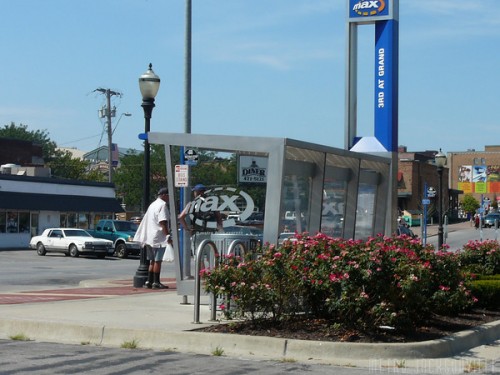
Local developers do not expect this to catalyze much development. The lack of heavy investment in infrastructure does not represent enough certainty when it comes to raising money to invest in new projects along these routes. Additionally, the time until LRT would be implimented hinders any sort of developing plans for this in the short term.
Essentially, Indyconnect planners traded out Washington Street light rail for even longer commuter rail routes representing limited investment in transit along the city’s most heavily trafficked local bus line. Why have our planners taken a known and existing line and scoffed at it, in exchange for a rail service which will offer less return on investment due to the potential for low ridership along commuter lines? Simply put, it’s much cheaper to rebuild old existing freight rail lines than it is to invest in new technology along Washington Street. Potential development along the Nickel Plate line is apparent inside of Marion County. No one can argue that. However, this is something that will need to be developed, and commuter rail service typically does not offer the frequency with which to stimulate optimum investment along its corridor.
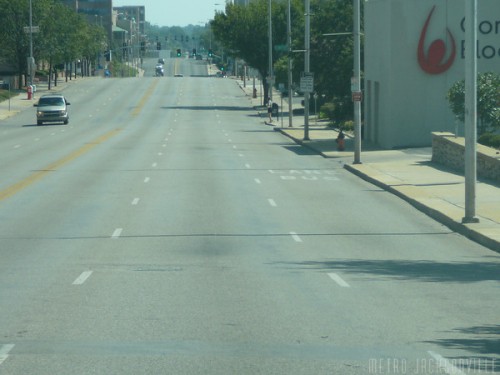
I struggle to advocate in this manner right now. Mostly, because I find it commendable that our leaders realize the need to grow bus ridership. I also follow other planning blogs that say, “Don’t quibble over the mode, only the route!” However, light rail investment attracts a higher ROI compared to bus, or commuter rail. Investment means new jobs and dense development patterns. In a city sorely lacking any sort of efficient transit oriented development, light rail on Washington Street would be a virtual overnight success. If the extensions of the NE and S commuter lines were returned to their prior planned termini and a plan hatched for Washington St LRT in the final approved version, investment would already be in the conversation; something that Mayor Ballard touted when the original plan was announced last February. An alternative could offer a compromise if TRUE BRT were to be constructed with a dedicated and seperated ROW and robust stations that provided the appearance of long term stability to citizens of Marion County. Much like what I showed from Cleveland in last week’s BRT post.
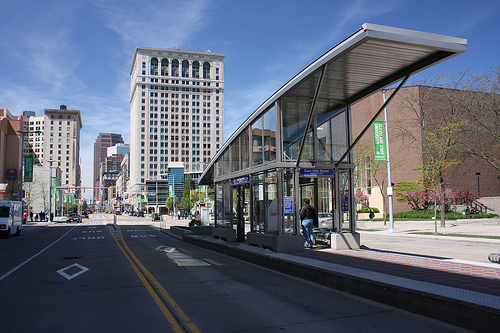
Peer cities would recognize our leap of faith in embracing either of the new technologies and would position us along with other cities we are commonly grouped with economically, most of which have robust transit systems with an expanding rail (or true BRT) component. I urge Indyconnect and the associated personal to rethink this oversight, and take a chance on something considered progressive and an almost guaranteed success.
Kansas City MAX photos from Metro Jacksonville
I’ll be the first one to admit that BRT’s, if not implemented correctly, can really screw things up. The question in my mind comes down to exactly how much money they’re planning on plunking down along these BRT routes. If they provide high-quality stations, then it may spur a reverse broken-windows effect in the neighborhood. 7-1/2 minute headways during rush out wouldn’t hurt, either. Coupled with existing development work (especially along Washington St) then I could see this being a very successful network that straddles the city.
.
And I think, rather, that the trade-off isn’t between light rail and extended heavy rail. The capital cost of plunking down light rail along Washington St. for approximately 10 miles would’ve cost approximately $150 million. Considering that we already have a problem in this city scraping together $50 million for an operating budget, I find it unlikely that the public would consent to investing that much capital along a corridor that hasn’t been lobbying for it for fifteen years, unlike the Northeast Corridor rail line.
.
Regardless of whether we choose rail or light rail or BRT’s or even — heaven forbid — subways or elevated rail, the main thing you should come away with from Indy Connect is that this is a massive coup for our bus system. If the Indy Connect initiative ends up falling flat on its face, then it could set back any and all transit development back for another twenty years. And fighting the fight to expand bus service in any form is a fight worth fighting, in my opinion, even if we can’t get the public on-board with light rail at this moment.
Yep…this article already proves how disastrous the revised INDY CONNECT BRT plan will be for Indianapolis UNLESS LRT is planned for the NEAR future. No matter how many buses you put on the street, the system will not be efficient, let alone spur economic development. It’s that simple. Let the bad news continue.
I was at the meeting last night too, and the planner mentioned that the LRT on Washington was going to cost 2.5X the commuter rail lines, so that if we built the LRT, we couldn’t build any other rail anywhere else. That would ensure that Hamilton and Johnson counties would not be paying taxes into the system, which would kill the plan.
Keep in mind the first Indy Connect plan was very high level, quick analysis. It’s not that they’re now using the Washington St LRT money on other things, it’s that everything probably costs more than originally thought, so there’s less money to go around. I’m sure the extensions into Noblesville and Franklin were a cheap way to get more citizens in those counties to vote for it.
I reckon that the “budget” for capital funds for light rail was shifted towards more operating costs. Given a capped budget (which I don’t think anyone is under any delusions that money is no object), then there’s only so much you can put into capital while still being able to operate that capital.
.
Considering that half of the $2.4 billion will be used in “running and maintaining the bus system” (Indy Connect’s words in the pamphlet they handed out) as distinct from the rail and BRT, then I have to hazard a guess that light rail’s significant costs (avg. cost was $15 million per mile, so for Washington St.’s 10 miles, that means $150 million) would have dug significantly into the budget they were playing around with.
I wonder how much the exact taxation level matters. To a large percentage of people, I think the question comes down to whether they are willing to be taxed AT ALL for a transit system. Whether the exact monthly household cost is $15 (the published estimate) or $16 is not something most people would care about.
My point is: if we’re taxing people to produce a transit budget of $2.4B, how many votes do you lose moving the taxation needle $150M to buy LRT? And how many votes do you gain by building the system that people are asking for? My instinct is that you’d gain much more than you lose.
Bob, there is no reason the City couldn’t create a redevelopment TIF district along the length of a Washington Street LRT line, issue bonds to cover capital cost, and make the payments out of the increased property taxes. A 30-year government-bonded “mortgage” on the capital cost would require maybe $10 million a year to carry…not $150 million up front. In the early years, the transit funding source would have to make up shortfalls in the TIF, but ultimately the development along the line would more than cover the cost.
.
The math: At a 2% residential/3% commercial property tax cap, it would take $300-500 million in property development to support the TIF, something that has been generated by LRT in other cities in almost every case. And to the extent that any development generated jobs, the county income taxes would be “gravy” to the city’s general fund. If the line lured as few as 2,000 jobs at an average wage of $50,000, that’s another $1.6 million in county income tax.
.
What’s missing from the IndyConnect “plan” is the kind of current cost and ridership information that citizens who want to be informed can access. It’s one thing to give public participants $100 in funny money and ask how they’d spend it: that amounts to creating a wish list. It’s something else entirely to lay out capital and operating costs for the proposed operations: that’s an actual PLAN. It is the latter that should be given a public airing before adoption of this plan by the regional transportation planning council.
.
“The public” deserves more transparency in government budgeting that accompanies long range plans…because it is through budgeting that these long-range plans are implemented (or become shelfware). If an agreed plan includes both a funding mechanism AND a relatively well-defined budget, then it will be a clearer sell come referendum time.
If they are looking to court the taxpayers from Noblesville and Franklin then using the existing route (nickel plate) to bring the cost down. Why not extend the route along the EXISTING tracks to Indianapolis International Airport?
It could be a good service to the;
3.8 million enplaned passengers for 2009, about 4,000 fed ex workers and many of the other logistics and distribution business in the area (airport city)
I’m sorry — this is just too funny and topical not to share: http://www.theonion.com/video/obama-replaces-costly-highspeed-rail-plan-with-hig,18473/
Yes, I watched that video about 5 times yesterday. The Onion is always welcome here on Urban Indy.
First off, using the freight lines that run from downtown to the airport would be problem plauged from the get go. Since CSX owns and operates these lines they are going to be leary of allowing any kind of non-Amtrak passenger rail on their tracks. This doesnt even account for the 25-30 freight trains that also traverse the same set of tracks making it a scheduling nightmare to make something like this happen.
Additionally, lets do some quick & dirty math on this project.
The airport to downtown line only, is approximatley 9 miles give or take depending on how we get to the terminal.
Here comes the quick & dirty math. It’s generally accepted that light rail cost anywhere from $20-$30 million a mile. When all costs are considered and distributed out per mile, that is about what it costs. Lets just say for the sake of argument that we shoot high and it’s $30 million / mile and we get approx $300 million once adding in utilities and short overuns.
If we can expect 50%-60% of that to be supported federally (not out of the question) we can put Marion County on the hook for $120-$150 million. Spread this cost out over 25 years of the long range plan being considered, and that is $4.8-$6 million a year that needs to be diverted to cover capital expenses associated with the Washington Street west side light rail. There are no bogus geographic landmarks to consider here so getting around a mountain or large river are not costs that we need to consider. Utility relocations, I have no idea about those costs and are generally considered by surveyors once the project gets rolling anyway, but could add a little bit more to the overall costs.
$6 million a year. Can’t we ask for that out of the roads budget? $9 billion (roads budget) divided out over 25 year, is $360 million per year. If we cant trim $6 million a year out of that for what I call Marion County’s reward for bearing a horrible transit system for years, then we need to be kicking more teeth in over this deal. Marion County is THE LANDMARK of this region and as such, should be regarded that way. Not by sending the sleek and attractive trains out to the suburbs. Those trains should be in Marion County where redevelopment NEEDS TO OCCUR so that our regions viability as an economic icon is reinforced and sustained for years to come.
A cheap-ass $20 million excuse for a BRT system is not going to attract anything like that and the rail lines going to Hamilton County and Johnson County will further add incentive to locate to those areas, much like the interstates do now.
The criteria used to compare the rapid transit systems should include capital, opearting and maitenance costs. But it should also include economic development near the system, transportation performance, sustainability, the potential to afford environmental improvements and land use. This initiative has not done that, and that’s why I’m disappointed. Also, you can not make generalizations about which mode would work better based on national or even regional average costs, because it will be different for each corridor, and there are two many different factors that are hard to compare.
Why cant we compare costs? Straight from one of the bean counters of HNTB who is at the core of this plan from an engineering stand point. THEY TALK TO PLANNERS WHO HAVE WORKED ON OTHER CITIES RECENT PROJECTS TO ESTIMATE COSTS. That is where the $20-$30 million a mile figure came from. Also, as I stated, west side LRT would be along an existing street that is flat and easily managed. They arent going to dig up an unforeseen aquifer or find a sinkhole. We know what is there. No surprises.
From looking up systems (wikipedia mainly), I think your costs are off, Charlotte was $48M/Mile, Minneapolis was $58M/Mile, Phoenix was $70M/Mile. That would make the entire Washington street corridor (Airport to eastside) between $1.1 and 1.5 Billion.
And there is ALWAYS surprises in construction.
Im sure there would be some surprises. And maybe I undershot a little. I was only estimating the west side line. But the costs arent that far off to be prohibitive. That was the overarching point.
This is what the people of Indy (mostly outside of this site [as we have seen not everyone sees things the same here]) and Indy Connect need to hear
@3:50: http://www.youtube.com/watch?v=dYOq0e7Id0E